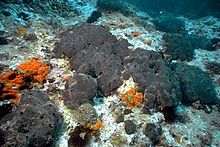| Spongia officinalis | |
|---|---|

| |
| Scientific classification | |
| Domain: | Eukaryota |
| Kingdom: | Animalia |
| Phylum: | Porifera |
| Class: | Demospongiae |
| Order: | Dictyoceratida |
| Family: | Spongiidae |
| Genus: | Spongia |
| Species: | S. officinalis
|
| Binomial name | |
| Spongia officinalis | |
| Synonyms | |
|
List
| |
Spongia officinalis, better known as a variety of bath sponge, is a commercially used sea sponge.[2] Individuals grow in large lobes with small openings and are formed by a mesh of primary and secondary fibers.[3][2] It is light grey to black in color.[3] It is found throughout the Mediterranean Sea up to 100 meters deep on rocky or sandy surfaces.[2][3][4][5][6][7]
Spongia officinalis can reproduce both asexually, through budding or fragmentation, or sexually.[8] Individuals can be dioecious or sequential hermaphrodites.[8] The free-swimming larvae are lecithotrophic and grow slowly after attaching to a benthic surface.[8][9][10]
Humans use and interact with S. officinalis in a variety of ways. Harvested sponges have been used throughout history for many purposes, including washing and painting.[2] Over-harvesting and sponge disease have led to a decrease in population.[2][3][11] Sponge fishing practices have slowly changed over time as new technology has developed and sponge farming is now in use to decrease stress on wild S. officinalis populations.[3][11] Sponge farming is also recommended as a solution to reducing marine organic pollution, especially from fish farms.[3][2][12][13]
- ^ Linnaeus, C. 1759: Systema naturæ per regna tria naturæ, secundum classes, ordines, genera, species, cum characteribus, differentiis, synonymis, locis. Tomus II. Editio decima, reformata. - pp. [1-4], 825-1384. Holmiæ. (L. Salvii).
- ^ a b c d e f Pronzato, Roberto; Manconi, Renata (2008). "Mediterranean commercial sponges: over 5000 years of natural history and cultural heritage". Marine Ecology. 29 (2): 146–166. Bibcode:2008MarEc..29..146P. doi:10.1111/j.1439-0485.2008.00235.x.
- ^ a b c d e f Pronzato, Roberto (1999). <485::aid-aqc362>3.0.co;2-n "Sponge-fishing, disease and farming in the Mediterranean Sea". Aquatic Conservation: Marine and Freshwater Ecosystems. 9 (5): 485–493. doi:10.1002/(sici)1099-0755(199909/10)9:5<485::aid-aqc362>3.0.co;2-n. ISSN 1052-7613.
- ^ Laubenfels, M.W. de. 1953: A guide to the sponges of Eastern North America. University of Miami Press. 32p.
- ^ Díaz, Humberto; Bevilcqua, Marina; Bone, David (1985). Esponjas en manglares del Parque Nacional Morrocoy (in Spanish). Fondo Editorial Acta Científica Venezolana. p. 64. OL 2655789M.
- ^ Cook, S.D.C., & Bergquist, P.R. 2002: Family Spongiidae Gray, 1867. Pp. 1051-1060. In Hooper, J. N. A. & Van Soest, R. W. M. (ed.) Systema Porifera. A guide to the classification of sponges. 1 (Kluwer Academic/ Plenum Publishers: New York, Boston, Dordrecht, London, Moscow).
- ^ Rützler, K., R. W. M. van Soest. & C. Piantoni. 2009: Sponges (Porifera) of the Gulf of Mexico, Pp. 285–313 in Felder, D.L. and D.K. Camp (eds.), Gulf of Mexico–Origins, Waters, and Biota. Biodiversity. Texas A&M Press, College Station, Texas.
- ^ a b c Baldacconi, R.; Nonnis-Marzano, C.; Gaino, E.; Corriero, G. (2007-09-01). "Sexual reproduction, larval development and release in Spongia officinalis L. (Porifera, Demospongiae) from the Apulian coast". Marine Biology. 152 (4): 969–979. doi:10.1007/s00227-007-0747-4. ISSN 1432-1793. S2CID 54594445.
- ^ "Esponjas (esponjas de baño)". Diccionario Monográfico del Reino Animal (in Spanish) (1a ed.). Barcelona: Bibliograf. 1980. p. 111. ISBN 84-71533-85-5.
- ^ Riesgo, Ana; Taboada, Sergio; Sánchez-Vila, Laura; Solà, Joan; Bertran, Andrea; Avila, Conxita (2015-03-18). "Some Like It Fat: Comparative Ultrastructure of the Embryo in Two Demosponges of the Genus Mycale (Order Poecilosclerida) from Antarctica and the Caribbean". PLOS ONE. 10 (3): e0118805. Bibcode:2015PLoSO..1018805R. doi:10.1371/journal.pone.0118805. ISSN 1932-6203. PMC 4365022. PMID 25785444.
- ^ a b Baldacconi, Rossella; Cardone, Frine; Longo, Caterina; Mercurio, Maria; Marzano, Carlotta Nonnis; Gaino, Elda; Corriero, Giuseppe (2010). "Transplantation of Spongia officinalis L. (Porifera, Demospongiae): a technical approach for restocking this endangered species". Marine Ecology. 31 (2): 309–317. Bibcode:2010MarEc..31..309B. doi:10.1111/j.1439-0485.2009.00299.x.
- ^ Stabili, Loredana; Licciano, Margherita; Giangrande, Adriana; Longo, Caterina; Mercurio, Maria; Marzano, Carlotta Nonnis; Corriero, Giuseppe (2006-09-01). "Filtering activity of Spongia officinalis var. adriatica (Schmidt) (Porifera, Demospongiae) on bacterioplankton: Implications for bioremediation of polluted seawater". Water Research. 40 (16): 3083–3090. doi:10.1016/j.watres.2006.06.012. ISSN 0043-1354. PMID 16884759.
- ^ Gifford, Scott; Dunstan, R. Hugh; O’Connor, Wayne; Koller, Claudia E.; MacFarlane, Geoff R. (2007-02-01). "Aquatic zooremediation: deploying animals to remediate contaminated aquatic environments". Trends in Biotechnology. 25 (2): 60–65. doi:10.1016/j.tibtech.2006.12.002. ISSN 0167-7799. PMID 17173992.